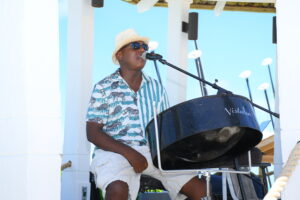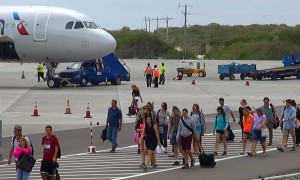News
Turks & Caicos Tourism Statistics 2016
Published
9 years agoon

Turks and Caicos, March 13, 2017 – Providenciales – The Turks and Caicos Islands is the fastest-growing destination in the Caribbean according to the latest statistical report from the Caribbean Tourism Organization (CTO). The destination welcomed and hosted some 1,300,575 tourists to its shores in 2016. While the majority of arrivals were cruise-based, 2016 marked an impressive, fifth consecutive year of growth in stopover arrivals. Further assessment of the 1.3 million arrivals in 2016 shows 453,612 visitors were stopovers and 846,963 arrivals came via cruise.
Stopover Arrivals
2016 marked a record setting year for the destination; for the first time the Turks and Caicos Islands received more than 400,000 stopover arrivals through our international airports and fixed based operations. Despite political uncertainties, security concerns and economic challenges in our major source markets, stopovers to the destination grew by a robust 17.5 percent in 2016 totaling 453,612 arrivals when compared to 385,531 arrivals in 2015.
For a consecutive year, the destination recorded growth in each month of the year and within the overwhelming majority of its major source markets. The growth rate ranged from a 27.4 percent increase in stopover arrivals recorded in September to a 7.5 percent increase in December of 2016. Lead by a strong first half, the destination welcomed 137, 641 stopover arrivals in the first quarter, an 18.5 percent increase in stopover arrivals when compared to the same period in 2015. Similarly the second quarter saw a 22 percent increase in stopover arrivals when compared to the same periods in 2015, welcoming 121,413 stopovers. The month of March saw 50,913 stopover arrivals, the most stopover arrivals of any month in 2016.
According to the recently released State of The Industry Report 2016 from the CTO, tourist arrivals among the destinations showed uneven growth. Of the 28 Caribbean destinations reporting data for varying periods between January and December, the Turks and Caicos Islands’ 17.5 percent increase in stopover arrivals lead the region. Besides our destination, 4 countries, Belize, Cuba, Guyana and Bermuda reported double digit growth rates. Six destinations experienced declines in stopover arrivals.
Major Market Trends
On par with the rest of the Caribbean, our destination’s strong performance in 2016 was primarily supported by the sustained economic growth and relatively low oil prices in the United States, our leading source market. Stopover arrivals from the United States in 2016 surged by 16 percent in comparison to 2015. The total number of stopover arrivals from the United States in 2016 was 365,854. Contributing factors to this performance includes greater accessibility to the destination, frequency of flights from most major gateways in the United States, and increased direct airlift to the destination.
Regionally there were over 14.6 million visitors from the U.S. according to CTO’s report, 3.5 percent more than the previous year. CTO attributed the region’s performance to solid economic growth, a low unemployment rate, and high consumer confidence in the U.S. Of the 28 destinations in the region reporting data, the Turks and Caicos Islands was among one of seven destinations recording double digit increases within the period, outdone only by Belize in the U.S. market. The other destinations included Bermuda, Antigua and Barbuda, Barbados, Grenada and Montserrat. Six destinations recorded declines in stopover arrivals from the United States.
While Canadian arrivals to the Caribbean fell by 3.4 percent in 2016, the Turks and Caicos Islands recorded a tremendous 23.2 percent growth in the Canadian market with 44,974 arrivals. More than 70 percent of the reporting destinations saw decreases in this market. According to CTO, a weak currency and sluggish first half economic output are among the contributing factors to the decline in Canadian trips to the Caribbean.
For the consecutive year, the Turks and Caicos Islands recorded the highest growth from the European market within the Caribbean region. Arrivals from the European totaled 14,556 and improved by 27.7 percent year-over-year, the strongest growth among the destination’s major markets. Stopover arrivals from the United Kingdom grew by 40.5 percent year-over year. Similarly, stopover arrivals from Italy and France also saw continual growth recording increases of 33.2 percent and 22.3 percent year-over-year, respectively. Combined, the destination welcomed 14,556 stopovers from the European market in 2016, up from 11,403 stopovers in 2015. A closer examination of stopover arrivals to the destination from the European market reveals 8,991 arrivals from the United Kingdom; 1,960 arrivals from Italy; 1,256 arrivals from France; 363 arrivals from Germany and a collective 1,986 arrivals from other European nations including Ireland, Luxemburg, Spain, Switzerland, etc.
Similarly, arrivals from the European market showed the strongest growth among the main markets in the Caribbean region. According to CTO, arrivals from the European market to the region totaled 5.6 million and improved by 11.4 percent, notwithstanding terrorist attacks in some countries, the fears and fallouts of Brexit, and the mixed economic outcomes across Europe. 72 percent of the reporting destinations registered increase in arrivals from the European market with St. Maarten, Guyana and Anguilla joining the Turks and Caicos Islands as top performing destinations.
Stopover arrivals to the destination from Brazil declined by 7.5 percent year-over-year, totaling 1,264 arrivals. The trend was the same regionally, as the Caribbean received 11 percent fewer arrivals from Latin America in 2016 compared to 2015.
Intra-regional travel has become a recent trend to the Turks and Caicos Islands due to destination’s rising popularity as an accessible hub for the best interconnectivity between the Caribbean islands. Travelers can access regional flight services from Providenciales, to multiple destinations in Antigua, The Bahamas, British Virgin Islands, Cuba, Dominican Republic, Haiti, Jamaica and Puerto Rico. In 2016 the destination welcomed 20,486 stopover arrivals from the Caribbean, a 21.3 percent growth rate year-over-year.
According to CTO, 2016 was another record-breaking year for Caribbean intra-regional travel, as arrivals rose by 3.6 percent for a consecutive year of growth, registering just over 1.7 million trips. Guyana, St. Vincent and the Grenadines, and the Turks and Caicos Islands were the top performing destinations reporting robust double-digit growth. 6,478 stopover arrivals visited the destination from the rest of the world, including countries in Asia, Africa and the Pacific.
Cruise Arrivals
While the destination continued to boost its stopover arrivals in 2016, for a consecutive year cruise arrivals took a downturn. The Grand Turk Cruise Center greeted a total of 846,963 cruise passengers, an 8.9 percent decline in cruise passengers year-over-year. Similarly, for a consecutive year the Cruise Center also welcomed fewer ships, hosting 284 compared to 317 ship calls in 2014; this marked a 10.4 percent decline in ship calls year-over-year.
The month of March showed the most significant growth rate in cruise passengers and ship calls to the Grand Turk Cruise Center, recording an increase of 25.6 percent and 13.3 percent respectively. The month of December saw a total of 97,799 cruise passenger arrivals, the most arrivals in any given month of the year, a 4.8 percent increase when compared to 2014 despite a 2.8 percent decline in ship calls for the month. Minor increases in cruise passenger arrivals were also recorded in the months of April, May, August and September despite having consistent or fewer ship calls when compared to the same periods in 2015.
October saw the largest decline in cruise passenger arrivals and ship calls to the destination helped by an active 2016 hurricane season. While the Turks and Caicos Islands was spared the wrath of Hurricane Matthew, regional neighbors sharing the same itineraries as Grand Turk such as the Dominican Republic, Haiti and The Bahamas were significantly damaged. Cruise passenger arrivals to Grand Turk decreased by 38.9 percent while ship calls were down by 44 percent in the month of October.
According to CTO’s report, 2016 was a record-breaking year for Caribbean cruising as cruise passenger arrivals to the region grew by 1.3 percent to reach 26.3 million. Overall 48 percent of the reporting Caribbean destinations registered growth with the best performances in the Dominican Republic, the British Virgin Islands and Grenada. Belize became the eighth Caribbean destination to ever reach the benchmark of 1 million cruise passenger arrivals.
There is no secret that grave challenges continue to threaten the cruise industry in Grand Turk. The ports underperformance for the consecutive year is an indication that an agreeable solution to a list of unresolved matters between Carnival Cruise Lines, operators of the Grand Turk Cruise Center, and the Turks and Caicos Government must be reached in a timely manner in order for Grand Turk to rebound.
Outlook
2016 was undoubtedly another successful year for the main revenue earner and top industry in the Turks and Caicos Islands despite the raise in the level of global uncertainty. While global uncertainty such as the implications of Brexit or any unforeseen events could still impact the performance of tourism in 2017 and beyond, the outlook for the destination remains strong. The Turks and Caicos Islands recently saw the debut of several new hotels in winter 2017, led by the ultra-luxurious resort The Shore Club and the boutique offerings of Beach Enclave North Shore both on Providenciales, as well as, the barefoot luxury of Sailrock resort on the undeveloped island of South Caicos. These new resort openings coupled with the recent announcements of Blue Cay Estate, a new luxury waterfront villa collection to be operated by the award-winning Grace Bay Resorts slated for first phase completion in mid-2017 and the debut of Beach Enclave Long Bay expected in late 2017, are welcome increases to the room inventory of the destination.
The Turks and Caicos Islands recently received a boost in its accessibility for potential visitors in mid-December 2016 as United Airlines introduced a nonstop flight on Saturdays from Washington D.C. to Providenciales, opening a new gateway to the destination.
The Turks and Caicos Tourist Board and its partners will continue to increase the destination’s presence within the market place by embarking on a series of travel and trade shows. Traditional and non-traditional media strategies, sponsorships, and promotional events in the United States, Canada, Europe and Latin America will also continue. The Board has renewed its commitment to working with wholesalers, hotel partners, airlines and cruise to sell the destination. In addition, the Turks and Caicos Islands is working to expand its hotel and tourism product beyond the traditional hub of Providenciales and Grace Bay Beach to the other beautiful islands, as demand for additional accommodation, attractions, and niche offerings has increased.
Source of Data: Sabre ADI System , Grand Turk Cruise Center and Provo Air Center
Source of Publication: Turks & Caicos Islands Tourist Board
#TCITourismStatistics2016 #TourisminTCI #visitTurksandCaicos
News
Beaches Turks and Caicos Showcases and Supports Local Creativity
Published
3 months agoon
September 12, 2025
September 12, 2025
PROVIDENCIALES, Turks & Caicos Islands – The Turks and Caicos Islands are home to a wealth of creativity, from artisans and craft vendors to musicians and performers. Beaches Turks and Caicos, the Caribbean’s leading all-inclusive family resort, has pledged its continued support for these individuals by providing meaningful platforms for them to share their skills and stories with guests from around the world.
The resort’s commitment is most evident in its weekly Cultural Night showcase, where visitors are immersed in the vibrant traditions of the islands. Guests enjoy live performances which feature local music genres such as ripsaw, while artisans display and sell handmade creations. This event not only enriches the guest experience but also strengthens economic opportunities for local entrepreneurs.
Entertainment Division Manager Garett Bailey emphasized the significance of Cultural Night, “we want to showcase everything the Turks and Caicos Islands culture has to offer. Our goal is for guests to leave with a deeper appreciation of the island’s art, music and traditions, while giving local talent the opportunity to share their creativity with visitors from across the globe.”
Beyond Cultural Night, Beaches Turks and Caicos also welcomes local craft vendors onto the resort every Wednesday and Friday where they are offered a direct space to market their goods. Guests have easy access to the Turks and Caicos Cultural Marketplace, where they can purchase authentic local arts and crafts.
where they are offered a direct space to market their goods. Guests have easy access to the Turks and Caicos Cultural Marketplace, where they can purchase authentic local arts and crafts.
Managing Director, James McAnally, highlighted how these initiatives reflect the resort’s broader mission, “we are committed to celebrating and sharing the vibrant culture of these islands with our guests. By showcasing local artistry and music, we not only provide entertainment but also help sustain and grow the creative industries of the Turks and Caicos Islands. From our cultural showcases to nightly live music, we are proud to create authentic connections between our guests and the people of these islands.”
Local musician Keon Hall, who frequently performs at the resort, expressed gratitude for the ongoing partnership, “being able to share my music with Beaches’ guests has created lasting relationships. Some visitors return year after year and request songs from previous performances. This partnership continues to celebrate what we do and strengthens the bond between local artists and the resort.”
The resort’s support of local artisans and entertainers extends beyond business opportunity; it is about preserving heritage and sharing stories. Guests take home more than souvenirs; they leave with experiences that deepen their understanding of Turks and Caicos’ culture and history.
Public Relations Manager, Orville Morgan, noted the importance of this commitment, “for many visitors, these interactions represent their first genuine connection to the Turks and Caicos Islands. From artisans and musicians to farmers and transport operators, our local talent helps shape every guest experience. At Beaches, we are proud to give them the stage to share their stories and their heritage.”
Beaches Turks & Caicos remains dedicated to developing cultural connections and supporting the artisans, musicians and entrepreneurs whose creativity makes the Turks and Caicos Islands unique. Each guest experience is an opportunity to celebrate and sustain the spirit of the islands.
Caribbean News
“Barbecue” is Cooked! US Turns Over 11 Million Haitians into Potential Informants with $5 Million Bounty
Published
4 months agoon
August 12, 2025
August 12, 2025
The United States just set fire to the underworld in Haiti — and this time, the smoke might finally flush out the man many call the most feared in the Caribbean.
On Tuesday, the U.S. government slapped a $5 million bounty on the head of Jimmy “Barbecue” Chérizier, the ex-police officer turned gang boss accused of orchestrating massacres, torching neighborhoods, and strangling Haiti’s capital into chaos. This isn’t just a headline — it’s a full-blown game-changer.
turned gang boss accused of orchestrating massacres, torching neighborhoods, and strangling Haiti’s capital into chaos. This isn’t just a headline — it’s a full-blown game-changer.
That kind of cash — offered under the State Department’s Transnational Organized Crime Rewards Program — is enough to turn the country’s entire population, more than 11 million people, into potential informants overnight. Add the millions in the Haitian diaspora, and Chérizier isn’t just wanted. He’s surrounded.
The Number That Changes Everything
Five million U.S. dollars today equals about 655 million Haitian Gourdes. In a country where many scrape by on less than $5 a day, that’s not just life-changing — it’s life-defining. It’s enough to rebuild homes, put generations through school, or buy a one-way ticket far from the gunfire.
In a place where trust is scarce and survival is everything, that figure is more than tempting — it’s irresistible. For Chérizier, it means every friend could be a future informant, and every loyalist might be calculating the cost of staying loyal.
‘We Will Find Them’ — Jeanine Pirro, U.S. Attorney
Jeanine “Judge Jeanine” Pirro, the U.S. Attorney, set the tone with fire in her voice. “This indictment is the first of its kind,” she announced. “Jimmy Chérizier, also known as ‘Barbecue,’ is a notorious gang leader from Haiti who has orchestrated and committed various acts of violence against Haitians, including the 2018 La Saline attack in which approximately 71 people were killed. He both planned and participated in that massacre.
“Anyone who is giving money to ‘Barbecue’ cannot say, ‘I didn’t know.’ They will be prosecuted, and we will find them. They are supporting an individual who is committing human rights abuses, and we will not look the other way.”
Pirro wasn’t just going after Chérizier. She was sending a warning to the Haitian diaspora accused of feeding his war chest from abroad: the days of claiming ignorance are over.
‘No Safe Haven’ — Darren Cox, FBI
Then came Darren Cox, Deputy Assistant Director of the FBI, delivering the muscle of America’s most powerful investigative force. “There is no safe haven for Chérizier and his network,” Cox declared. “We are closing every link, every cell.” Since January, he said, the FBI has arrested three Top Ten fugitives, taken more than 19,000 criminals off the streets, and seized thousands of tons of narcotics — enough to save millions of lives across the U.S.
The FBI’s Miami and Houston offices have already bagged one of Chérizier’s Viv Ansanm associates inside the United States without firing a shot. “These efforts are a deliberate and coordinated plan,” Cox said, “to protect our communities and confront escalating threats from terrorist organizations like Viv Ansanm.”
‘Three-Year Investigation’ — Ivan Arvelo, HSI
Ivan Arvelo, Assistant Director of Homeland Security Investigations, brought the receipts. “This is the result of a three-year investigation into Chérizier’s procurement networks, cash pipelines, and operational financing that violates sanctions,” he explained. Arvelo described 400 structures destroyed, entire communities erased, and a gang exploiting U.S. dollars, technology, and immigration loopholes to keep its killing machine running. “We tracked how Americans unwittingly bankrolled brutality,” he said — proof that the net is tightening both inside Haiti and abroad.
‘The Worst of the Worst’ — Chris Lambert, State Department
Chris Lambert, representing the State Department’s International Affairs division, gave the political bottom line.
“Mass violence in Haiti must end,” Lambert said. “The instability resulting from Chérizier’s actions fuels illegal migration, regional instability, and transnational crime. We will continue to apply every tool available — including our rewards programs — to stop the spread of unchecked violence, especially to target the worst of the worst criminal leaders threatening the people of our hemisphere.”
instability, and transnational crime. We will continue to apply every tool available — including our rewards programs — to stop the spread of unchecked violence, especially to target the worst of the worst criminal leaders threatening the people of our hemisphere.”
Lambert confirmed what many have long known: Chérizier is not just a gang leader. He commands Viv Ansanm, officially designated in May as a Foreign Terrorist Organization. In the eyes of the U.S., that makes him not just Haiti’s problem — but everyone’s.
Why Haitians May Not Resist
In Haiti, money talks — loudly. And when you put 655 million Gourdes on the table, it shouts.
That’s the kind of figure that turns casual acquaintances into informants and makes even the most hardened loyalist wonder if the payout is worth more than the risk. It’s not a matter of “if” word gets out, it’s a matter of “who will be first to collect.”
For grieving families, it’s a chance at justice. For the desperate, it’s a chance at survival. For Haiti as a whole, it’s hope — wrapped in the most dangerous of temptations.
An Answer to Prayers
For years, Haiti’s headlines have been a scroll of horrors — kidnappings, executions, burned neighborhoods, bodies in the streets. Chérizier’s name has been attached to too many of them.
This move by the U.S. isn’t just strategy. It’s personal. It’s a signal to every Haitian — at home or abroad — that the days of impunity could be ending.
I’ll admit it: when I heard the news, I danced, I sang, and I nearly cried. Not because $5 million is a lot of money, but because of what it means — the possibility, at last, of stopping the man accused of helping turn Haiti into hell on earth.
Four officials, four angles, one mission: Pirro’s fire, Cox’s grit, Arvelo’s precision, Lambert’s conviction. Together, they’ve put the heat on “Barbecue” like never before.
BBQ is cooked. The only question now is: which one of over 11 million potential informants will serve him up?
Africa
What If Caribbean Dollars Flowed to Africa? A Trade Revolution Within Reach
Published
4 months agoon
August 8, 2025
By Deandrea Hamilton | Editor
What would happen if the Caribbean started spending more with Africa?
That question is no longer hypothetical. It’s the vision behind a growing movement that sees the Caribbean not just as a neighbor of the Americas, but as a key partner in the rise of a “Global Africa.” With shared history, deep cultural ties, and emerging trade frameworks, experts say the potential is enormous—if the will to act finally matches the passion of the speeches.
Billions on the Table
Today, trade between Africa and the Caribbean sits at just over US $729 million annually. But the International Trade Centre (ITC) and Afreximbank project that number could balloon to US $1.8 billion per year by 2028—more than doubling in just a few years.
This boost is expected to come not just from commodities, but increasingly from services, particularly in transport, travel, food exports, and creative industries. Two-thirds of that growth, according to analysts, could come from services alone—sectors where the Caribbean is eager to expand. (afreximbank.com).
Meanwhile, Africa’s consumer and business spending is forecasted to skyrocket to US $6.66 trillion by 2030, driven by a population boom and rising middle class.
The Case for a New Trade Axis
The Caribbean imports 80% of its food, but many of those goods can be sourced from African markets. What we offer in return? World-class logistics, tourism know-how, financial services, and proximity to the U.S. market. It’s a natural fit—one that is currently underdeveloped.
The recent call by Grenadian Prime Minister Dickon Mitchell for a “Global Africa Commission” underscores this urgency. He urged stakeholders at the Afreximbank Trade Expo to stop the cycle of empty talk and get to work: building shipping routes, finalizing trade agreements, and boosting knowledge of what each region actually has to offer.
urged stakeholders at the Afreximbank Trade Expo to stop the cycle of empty talk and get to work: building shipping routes, finalizing trade agreements, and boosting knowledge of what each region actually has to offer.
“We will not leave here with another communiqué,” Mitchell continued. “We will leave here with a commitment to act, to build together, to trade together, to succeed together and rise together.” The statement underscored a central theme of the summit — that both Africa and the Caribbean can no longer afford to admire the idea of unity; they must operationalize it.Pilot platforms like the Pan-African Payment and Settlement System (PAPSS) are already simplifying how cross-border payments work between African countries—and could extend to Caribbean partners. The system removes the need for U.S. dollars in trade between African nations, creating space for sovereign empowerment.
What’s the Hold-Up?
Let’s be blunt: political will, slow bureaucracies, and lack of coordination are stalling real action. Despite a decade of “Africa–Caribbean unity” talk, less than 3% of CARICOM trade currently involves the African continent. That fact continues to undermine these brave speeches and ambitious notions.
Where Caribbean Consumers Fit In
Caribbean consumers—especially the younger, tech-savvy generation—are already looking for affordable, ethical, and culturally relevant goods. African markets offer exactly that. Redirecting even a fraction of spending toward African-made clothing, beauty products, tech tools, or agro-processed foods could start a real trade revolution.
Bottom Line
If the political leaders won’t build the bridge fast enough, maybe Caribbean consumers will. The money is there. The interest is rising. Now it’s time to turn the “Global Africa” vision into a real economic shift—one shopping cart at a time.















